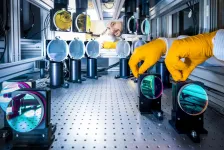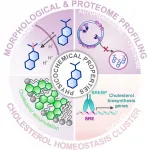(Press-News.org) Around 50,000 people suffer sudden cardiac arrest in Germany every year. When occurring outside a hospital, the chances of survival are only ten percent. Survivors often suffer from severe permanent neurological damage. On July 21st, 2021, researchers from the Faculty of Medicine - University of Freiburg, Germany, published together with German and US colleagues a review article in the journal Nature Reviews Neuroscience. They describe the most important therapeutic factors for successful resuscitation. The scientists name the therapy concept based on these factors CARL (Controlled Automated Reperfusion of the whoLe body). In recent years, the Freiburg physicians and perfusionists have already developed a special and mobile heart-lung machine for resuscitation that allows a CARL therapy for the first time. One of the first persons treated with CARL therapy successfully survived a cardiac arrest after about 120 minutes of resuscitation. The affected person suffered no brain damage.
„After decades of research, we were able to develop a new treatment method to reduce the physical damage that would otherwise occur after cardiac arrest and resuscitation. Our findings and the device we developed could be of great importance for emergency medicine," said Prof. Dr. Friedhelm Beyersdorf, Medical Director of the Department of Cardiovascular Surgery at Medical Center - University of Freiburg. „The CARL method incorporates the latest basic research and state-of-the-art cardiac surgical techniques. Through innovative medical technology developments of our own, we now have the opportunity to apply this new treatment principle inside and outside the hospital. This raises the prospect of people surviving much longer and better after cardiac arrest than was previously thought," Beyersdorf said.
Success factors for resuscitation
As a result of cardiac arrest, blood vessels in the brain swell, making them less permeable to gas exchange. „By maintaining a high, pulse-like blood pressure during controlled whole-body reperfusion (CARL therapy), we can resuscitate the brain most quickly," Beyersdorf says. Oxygen levels must be low and increased only slowly. Otherwise, free radicals are generated in the tissues. These very aggressive molecules can then attack, among other things, the mitochondria, the power plants of the cells. A reduced calcium concentration in the blood also helps to protect the mitochondria. „It is very important to lower the body temperature of the patients as quickly as possible in order to slow down metabolic processes," explains the Freiburg cardiac surgeon, who published the study together with colleagues from Yale University, USA, and Max Planck Institute for Metabolic Research, Germany.
CARL - For the first time, resuscitation therapy in its complexity is possible
Some of the aspects were known in principle, but not in the depth of detail. In addition, various aspects of therapy were not technically feasible until now. That is why scientists at the Medical Center - University of Freiburg founded the startup Resuscitec a few years ago, where they developed a device that specifically meets the complex requirements of resuscitation: the CARL system.
„To our knowledge, CARL is the first device that was developed specifically for resuscitation and can take over the complete cardiopulmonary function of the patient. With CARL we can treat the damage caused by cardiac arrest and the associated lack of oxygen. This is possible because we can immediately measure and control all the important parameters, such as blood values, that are necessary for successful resuscitation," says Prof. Dr. Christoph Benk, Head of Perfusion at the Department of Cardiovascular Surgery at Medical Center - University of Freiburg.
A unique dual-pump control system enables the necessary high pulsatile blood flow and realizes a high blood pressure, oxygen levels can be precisely controlled, and a mobile cooling unit allows the patient's body to be cooled down quickly and safely. „The device is designed relatively small and light so that it can fit in the ambulance and be carried directly to the patients," explains Benk.
First CARL deployments give great hope
In an initial pilot study, the doctors were able to save many of the patients treated with CARL therapy even though resuscitation time was very long, ranging from 50 to 120 minutes. „In the case of a 43-year-old patient, resuscitation was successful after 70 minutes. The patient has fully recovered and is back to working as a teacher," says Prof. Dr. Georg Trummer, Head of cardiovascular surgical Intensive Care Unit in the Department of Cardiovascular Surgery at Medical Center - University of Freiburg. In another case, a patient suffered cardiac arrest at home and was brought to the Medical Center - University of Freiburg by helicopter after first responder resuscitation. „Here, the patient was immediately connected to the CARL device and - after 120 minutes - successfully resuscitated," Trummer said. The patient suffered no brain damage and was able to return to her job. To back up these initial promising results, a study is now planned at three European universities as part of the European Commission's Horizon 2020 program.
INFORMATION:
Conflicts of interest
Prof. Dr. Friedhelm Beyersdorf is founder and shareholder and Prof. Dr. Christoph Benk and Prof. Dr. Georg Trummer are part-time employee and shareholder of the company Resuscitec, a start-up company of the University Hospital Freiburg.
Original title of the study: Brain vulnerability and viability after ischemia.
DOI: 10.1038/s41583-021-00488-y
Further information: http://www.nature.com/articles/s41583-021-00488-y
Published case study: https://pubmed.ncbi.nlm.nih.gov/28693585/
Key Takeaways
A survey of American College of Surgeons members found almost two-thirds treat firearm injuries and more than 85 percent support the organization advocating for policies to reduce firearm-related injuries.
Forty-two percent of ACS members keep firearms in their homes and nearly one-third (32 percent) of surgeon firearm owners store firearms unlocked and loaded.
Survey findings will enable the ACS to identify ways to engage all members, including gun owners, and advocate for initiatives that prevent firearm-related injuries.
CHICAGO (July 22, 2021): In what may be the largest survey of physician attitudes about firearms and how firearm-owning surgeons store guns in their homes, U.S. members of the American College of Surgeons ...
Scientists at Cambridge and Leeds have successfully reversed age-related memory loss in mice and say their discovery could lead to the development of treatments to prevent memory loss in people as they age.
In a study published today in Molecular Psychiatry, the team show that changes in the extracellular matrix of the brain - 'scaffolding' around nerve cells - lead to loss of memory with ageing, but that it is possible to reverse these using genetic treatments.
Recent evidence has emerged of the role of perineuronal nets (PNNs) in neuroplasticity - the ability of the brain to learn and adapt - and to make memories. ...
In the depths of space, there are celestial bodies where extreme conditions prevail: Rapidly rotating neutron stars generate super-strong magnetic fields. And black holes, with their enormous gravitational pull, can cause huge, energetic jets of matter to shoot out into space. An international physics team with the participation of the Helmholtz-Zentrum Dresden-Rossendorf (HZDR) has now proposed a new concept that could allow some of these extreme processes to be studied in the laboratory in the future: A special setup of two high-intensity laser beams could create conditions similar to those found near neutron stars. In ...
Over the last few decades, neurodegenerative diseases became one of the top 10 global causes of death. Researchers worldwide are making a strong effort to understand neurodegenerative diseases pathogenesis, which is essential to develop efficient treatments against these incurable diseases. However, our knowledge about the basic molecular mechanisms underlying the pathogenesis of neurodegenerative diseases is still lacking. A team of researchers found out the implication of lysosomes in the spread of Parkinson's disease.
The accumulation of misfolded protein aggregates in affected brain regions is a common hallmark shared by several neurodegenerative diseases (NDs). Mounting evidence in cellular and in animal models highlights the capability ...
Artificial intelligence tools and deep learning models are a powerful tool in cancer treatment. They can be used to analyze digital images of tumor biopsy samples, helping physicians quickly classify the type of cancer, predict prognosis and guide a course of treatment for the patient. However, unless these algorithms are properly calibrated, they can sometimes make inaccurate or biased predictions.
A new study led by researchers from the University of Chicago shows that deep learning models trained on large sets of cancer genetic and tissue histology data can easily identify the institution that submitted the images. The models, which use machine learning methods to "teach" themselves how to recognize certain cancer signatures, ...
Replication of SARS-CoV-2, the virus responsible for COVID-19, depends on a series of interactions between viral proteins and different cellular partners such as nucleic acids (DNA or RNA). Characterizing these interactions is crucial to elucidate the process of viral replication and identify new drugs for treating COVID-19.
An interdisciplinary consortium of scientists from the Institut Pasteur, the Ecole Polytechnique, the Institut Curie, Inserm, the CNRS and the universities of Paris, Paris-Saclay, Bordeaux and Toulouse have demonstrated a specific interaction between a domain of a SARS-CoV-2 protein (Nsp3) and ...
When Alexander Flemming discovered a mould on a culture plate overgrown with bacteria in 1928, he did not expect to find one of the most widely used active substances: penicillin. Accidental discoveries and the identification of active ingredients from traditional remedies, such as the morphine of the opium poppy, have shaped the discovery of new medicines for a long time.
Modern drug discovery - from chance to system
Meanwhile, major developments in chemistry and molecular biology have been made that enable a systematic and targeted search for potential active substances in modern drug discovery. First, advances in the field of organic and ...
TROY, N.Y. -- An innovative testing platform that more closely mimics what cancer encounters in the body may allow for more precise, personalized therapies by enabling the rapid study of multiple therapeutic combinations against tumor cells. The platform, which uses a three-dimensional environment to more closely mirror a tumor microenvironment, is demonstrated in research published in Communications Biology.
"This whole platform really gives us a way to optimize personalized immunotherapy on a rapid, high throughput scale," said Jonathan Dordick, Institute Professor of chemical and biological engineering and member of the Center for Biotechnology and Interdisciplinary Studies (CBIS) at Rensselaer Polytechnic Institute, ...
It's a favourite first-order for the day, but while a quick coffee may perk us up, new research from the University of South Australia shows that too much could be dragging us down, especially when it comes to brain health.
In the largest study of its kind, researchers have found that high coffee consumption is associated with smaller total brain volumes and an increased risk of dementia.
Conducted at UniSA's Australian Centre for Precision Health at SAHMRI and a team of international researchers*, the study assessed the effects of coffee on the brain among 17,702 UK Biobank participants (aged 37-73), finding that those who drank more than six cups of coffee a day had a 53 per cent increased risk of dementia.
Lead researcher and UniSA PhD candidate, ...
Silicon, a semi-metal, bonds in its natural form with four other elements and its three-dimensional structure takes the form of a tetrahedron. For a long time, it seemed impossible to achieve the synthesis and characterisation of a two-dimensional equivalent - geometrically speaking, a square. Now scientists from the field of Inorganic Chemistry at Heidelberg University have succeeded in producing a crystalline complex with such a configuration. PD Dr Lutz Greb from the Institute of Inorganic Chemistry underlines that it has surprising physical and chemical properties and, in the field of molecular chemistry, will open up new approaches to using the second most abundant element in the Earth's crust for catalysis and materials research.
As a classical ...

